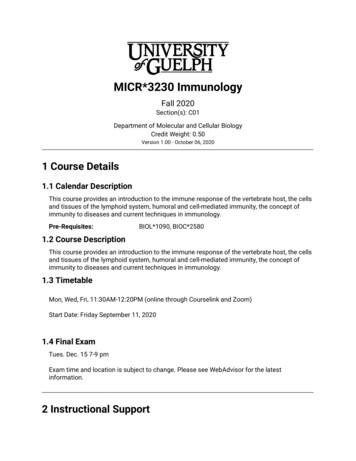Immunology Of Pregnancy - NICHD
Immunology-InflammationGil Mor M.D., Ph.D.Professor and DirectorDivision of Reproductive SciencesReproductive Immunology UnitDepartment of Obstetrics, Gynecology& Reproductive SciencesYale University School of MedicineEditor in Chief, American Journal of Reproductive Immunology1
Immunology of PregnancyMedawar recognized the paradox thatthe fetus is (in genetic terms) a semiallograft which escapes rejection.The presence of immune cells at theimplantation site has been consideredas a proof of a response by the maternalimmune system to the fetus2
Immunology of PregnancyThe studies in the area of Immunologyof Pregnancy have focused on GraftHost response3
Immunology of Pregnancy:Old ParadigmsMechanical BarrierSuppression of the Maternal ImmuneSystemTh-2 type Immune Response4
Mechanical Barrier: OldThe placenta prevents the movement ofcells and antigens from the fetus to themother and from the mother to the fetus5
Mechanical Barrier: NewEvidence for traffic in both directionsacross the maternal-fetal interfaceincludes studies reporting migration ofmaternal cells into the fetus and thepresence of fetal cells in the maternalcirculation.6
Suppression of the maternalImmune System: OldPregnancy is characterized by a state ofimmune suppression7
Suppression of the MaternalImmune System: NewMaternal antiviral immunity is notaffected by pregnancyHIV pregnant women do not suffer fromAIDS-like disease Systemic Immune Suppressionrepresents a danger to the species
Pregnancy is a TH2Inflammatory condition: OldPregnancy is a TH2 condition andinflammation is detrimental forpregnancy
Inflammation and Pregnancy:NewInflammation is necessary for Implantationand parturition
Inflammation and WoundRepair: The implantation wound
New Aspects for PlacentaMaternal Immune InteractionsRole of the maternal immune systemduring pregnancyRole of the placenta as an immuneregulatorRole of the placenta during infection
The Role of Maternal ImmuneCells During Pregnancy:Effect of Depletion of MaternalImmune cells
Maternal Immune System:Necessary for the Success ofPregnancyNatural Killer Cells- transformation of theblood vessels by the trophoblastMacrophages- Migration and survival ofthe trophoblastT Regs- Maintenance of toleranceDendritic Cells-Implantation15
Redefining theImmunology of Pregnancy16
The Placenta is an ImmuneRegulatory Organ17
Natural Killer CellsInner Cell MassMacrophageBlastocystCavityBlood VesselsTLRTrophoblastDendritic CellsT-regBacteriaNeutrophils
Trophoblast Maternal ImmuneInteractionsGraft/Host response vs Tumor/immuneinteractions
The Placenta as a NaturalTumor
Immune cells Promote Cancer cellsmigration, invasion and vascularization
Immune cells Promote Trophoblast cellsmigration, invasion and vascularization
Infection and Pregnancy:Old ParadigmsResponse to infection during pregnancyhas focused on the maternal immunesystem as the main and only player.Maternal immune system is suppressedto prevent responses to paternalantigens.Increased mortality during pregnancydue to infection has been attributed tomaternal immune suppression.23
VirusBacteriaMotherPlacentaFetusResponse
Infection and Pregnancy:New Paradigms.The maternal immune system is notsuppressed during pregnancy.The placenta plays a critical role in theresponse to infections, affecting not onlythe fetus but the maternal systemicimmune response.
Infection and PregnancyTherefore:– There are major limitations to ourunderstanding of the role of infection duringpregnancy.– These limitations have a severe impact onhow we: Identify women at risk for preterm birth Treat pregnancy complications due to infections Prevent maternal mortality during pandemics
VirusBacteriaBacteriaMotherPlacentaFetusResponse
The inflammatory status of the placentawill influence the development of thefetal immune system as well as thematernal immune responses.
Immunology-Inflammation Gil Mor M.D., Ph.D. Professor and Director Division of Reproductive Sciences Reproductive Immunology Unit Department of Obstetrics, Gynecology& Reproductive Sciences Yale University School of Medicine Editor in Chief, American Journal of Reproductive Immunology 1
US intrauterine pregnancy: reproducible loss heart activity, failure increase CRL over 1 w or persisting empty sac at 12 w Ectopic pregnancy blood/urine hCG, gestational sac outside uterus Heterotopic pregnancy Intrauterine ectopic pregnancy Pregnancy of unknown location (PUL) No identifiable pregnancy on US with blood/urine hCG
Discuss prevalence of teenage pregnancy. 2. Discuss pregnancy screening in teen population. 3. Identify pregnancy risks associated with teenage pregnancy for the mother. 4. Discuss medical impacts associated with teenage pregnancy for the fetus/infant. 5. Discuss social implications of teenage pregnancy. 6. Discuss risk for repeat unintended .
BI3023 Immunology II - Immunity in Disease Various Paper 2 1 of 2 Questions 20 marks Immunology I & II Various Paper 2 1 other Q 20 marks General module material (inc. Practicals) Various Paper 2 Short Questions 10 marks Lecture MCQ Immunology I material Various In-class MCQ 5 marks Practical 1 Phagocytosis Rachel McLoughlin Write-up 2.5 marks
MICR*3230 Immunology Fall 2020 Section(s): C01 Department of Molecular and Cellular Biology . Immunology (Textbook) Immunology, 8th Edition, 2013, by Judith A. Owen, Jenny Punt, Sharon A. Stanford. . (Kuby 8th Immunology
allergy & immunology tottori allergy & asthma assoc paner, kathrina pa allergy & immunology yes allergy & immunology southwest allergy and asthma pinna, kenneth r md allergy & immunology yes allergy & immunology pulmonary associates roberts, pa
Health Disparities: Bridging the Gap . The NICHD Mission. Since its inception in 1962, the National Institute of Child Health and Human Development (NICHD) has dedicated its research to understanding the dynamic biological,
Ectopic pregnancy-Right Tubal Pregnancy Blastocyst implants at abnormal site outside uterus Sites: Uterine tubes (tubal pregnancy) Ovary (ovarian pregnancy) Abdominal cavity (abdominal pregnancy) Intrauterine portion of uterine tubes (cornual pregnancy)
This study investigated microRNA and mRNA expression and protein function associated with DNA repair in human oocytes and embryos. MicroRNAs have been shown to down-regulate and in some cases to stabilise the expression of several genes including repair genes. The first aim of this study was to analyse the differences in the expression of microRNAs and their target mRNAs involved in repair .























